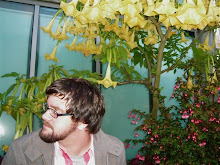I spent most of Thursday near the small town of Carson, Iowa, at my woodworking pal Skip's house. I met Skip soon after Niz and I got married at Skip's cousin, Eddith's house. He found out I do some woodworking and invited me to help the next time he milled some logs. The 'next time' was Thursday, and it was the most entertaining and educational experience I've had since I visited Thailand earlier this year.
I've visited a couple local sawmills but have never seen the portable milling process that Skip's sawyer buddy, Andy, orchestrated Thursday.

We started by loading single logs onto a stationary frame. Andy operated a series of hydraulics to turn and stabilize each log against the frame. Next, he positioned the portable mill's blade - which is essentially a sideways bandsaw - for the correct depth, and cut the log into a square pillar, rotating the log 1/4 turn after each cut in order to remove most of the bark. When the log was squared, Andy cut 5/4" thick (that's 1 & 1/4" thick) strips from the log, rotating it occasionally in order to make the ideal piece of lumber each time. As the blade finished each cut, we pulled the freed slabs of lumber away and placed them on a series of drying racks. Surprisingly, the freshly cut wet, or "green" lumber was about the same color as the dry wood will be.

The day was not without a couple hiccups. One of the logs Skip was most excited about milling was a long, straight trunk of ash. Skip was having the log
quartersawn (if interested in a quick, reliable tutorial about the differences in how wood is milled, go
here). Sometimes, particularly with oak logs, this milling process results in revealing a unique and desirable surface grain highlighted by a sort of pattern of reflective... flecks. Boards cut this way also tend to be more stable, in terms of their reaction to humidity.

Unfortunately, as the ash log was being cut in half, the blade ran into a nail. And a piece of wire. Likely, they were part of a farmer's fence decades ago, and had grown into the tree over time. Even a small piece of metal like a nail can take a major toll on a saw blade. Usually, nails and other pieces of metal (bullets and similar shrapnel are also common) are found by running a hand-held metal detector across the surface of each log. However, these surprise pieces were buried deep inside the tree. The dark spot near the middle of each half of the log shown at right is a stain in the vicinity occupied by the nail. These annoyances were balanced by the fact that the weather couldn't have been milder for July and I didn't lose any fingers.

By the end of the day we'd milled several logs of cherry, walnut, ash, burr oak (our region's version of white oak) and hickory, all harvested from Skip's land. The lumber will rest on Skip's drying rack for about a year, at which time I'll head back over to Carson and collect my wood-wages for the day. More importantly, I have a better understanding of a fundamental step in bringing a tree into fruition as a new object.











